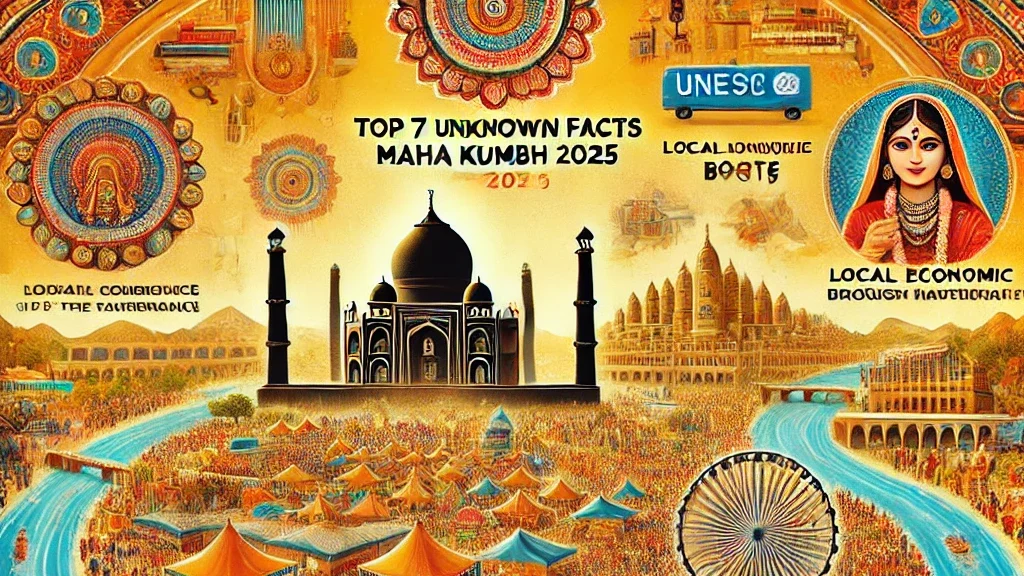Uncover the top 7 unknown facts about Maha Kumbh 2025, an extraordinary event that celebrates spirituality, unity, and faith at one of the world’s largest gatherings of devotees.

The world-famous Maha Kumbh, one of the largest spiritual gatherings, has officially begun. Celebrated every 12 years, it draws millions of devotees to Uttar Pradesh, particularly to Prayagraj’s Triveni Sangam, the sacred meeting point of the Ganga, Yamuna, and Saraswati rivers. Kumbh Mela, held every three years, alternates between four holy sites: Haridwar, Prayagraj, Ujjain, and Nashik, each tied to significant Hindu traditions. This cultural and spiritual event offers a chance to experience devotion and unity. Here are seven lesser-known facts about the Maha Kumbh 2025 that might amaze you.
List of 7 Unknown Facts About Maha Kumbh 2025
1. Largest Gathering on Earth
Maha Kumbh Mela 2025 is set to host over 45 crore participants, making it the world’s largest peaceful gathering. Millions of devotees, tourists, and visitors will come together in Prayagraj, Uttar Pradesh, to take part in sacred rituals and a holy dip in the Triveni Sangam. One of the most important facts about Maha Kumbh 2025 is that its a largest gathering on earth.
2. UNESCO Recognition
The Kumbh Mela holds global significance as it was recognized as an “Intangible Cultural Heritage of Humanity” by UNESCO in 2017. This prestigious acknowledgment highlights the event’s cultural importance on the international stage. One of the most popular unknown facts about Maha Kumbh is that its a UNESCO recognised.
3. The Naga Sadhus
Naga Sadhus, unique monks known for their ascetic lifestyle, play a significant role in the Maha Kumbh Mela. Their rituals, including bathing in freezing waters, symbolize deep spiritual devotion. At past gatherings, sadhus have showcased extraordinary acts like wearing 11,000 rudrakshas or growing crops on their heads.
4. The Importance of Sacred Bathing
A dip in the sacred waters of the Triveni Sangam, where the Ganga, Yamuna, and Saraswati rivers converge, is believed to wash away sins and lead to salvation (moksha). Bathing during this auspicious event holds immense religious significance.
5. Types of Kumbh Mela
- Maha Kumbh Mela: Held every 144 years in Prayagraj, it is the rarest and most sacred.
- Purna Kumbh Mela: Celebrated every 12 years across four holy sites: Haridwar, Prayagraj, Ujjain, and Nashik.
- Ardh Kumbh Mela: Takes place every six years in Haridwar and Prayagraj.
- Magh Mela: Observed annually in Prayagraj during January-February, a smaller but significant event.
6. Mythological Origins
The Kumbh Mela’s origins trace back to Hindu mythology, where drops of Amrit (nectar of immortality) spilled at four locations during a cosmic battle between Gods and demons, sanctifying these sites forever.
7. Economic Growth and Unity
Maha Kumbh Mela 2025 will boost the local economy, generating opportunities in tourism, hospitality, transport, and food sectors. Beyond its economic impact, the event unites people from diverse backgrounds, showcasing India’s spiritual diversity and cultural richness.
Maha Kumbh 2025 is more than a festival; it is a grand celebration of faith, unity, and tradition that continues to mesmerize the world.
Keep visiting The Ganga Times for such beautiful articles. Follow us on Facebook, Twitter, Instagram, and Koo for regular updates.
